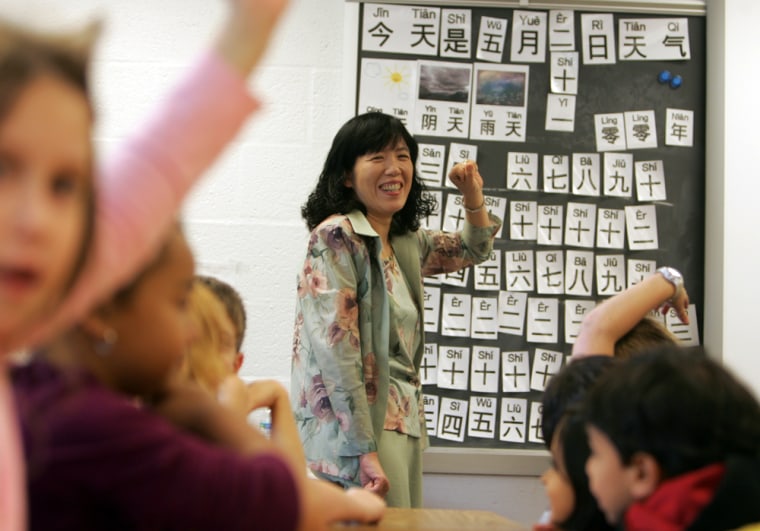The first-graders in Grace Yuan's class are playing "Jeopardy," eagerly responding to clues about animals and their habitats, diet and movements.
Sound routine for a group of 7-year-olds? Well, look again. These clues are in Chinese.
One girl, a bit uncertain, pondered the Chinese characters and pictures of animals. "Believe in yourself, Rachel," a classmate yelled. Applause rang out when she gave the correct response.
The class is a result of the National Security Language Initiative, introduced by President Bush in 2006 to teach the youngest students Chinese and other foreign languages considered critical to the nation's future security.
"We're going to teach our kids how to speak important languages," he said. One goal, he added, was "to advance America's interests around the world, and defeat this notion about our - you know our bullying concept of freedom by letting people see what we're about."
At Providence Elementary School here in Fairfax, principal Joy Hanbury believes that learning Chinese will stand today's children in good stead.
"We are looking at how global our world is," she said.
Emphasis on 'critical needs' languages
The federal program is based on the premise that you can engage foreign governments and their citizens more effectively when you speak their language. The emphasis is on "critical needs" languages, including Chinese, Arabic, Russian, Hindi and Farsi.
The Education Department, one of four federal agencies involved in the program, has awarded 88 grants totaling about $26 million to communities around the country to expand instruction in these languages beginning in kindergarten.
Chinese, thus far, has been the most popular.
"People understand in a competitive world, you've got to be fluent in the languages where business is booming, and China is one of those places," said Holly Kuzmich, the Education Department's deputy chief of staff.
Studies have shown that young children are much quicker than adults to pick up foreign languages. Other research suggests that elementary school students performed better in other subjects if they also took a foreign language.
"We do have pretty compelling data that show there are really good reasons to put in good programs at the elementary level," said Marty Abbott of the American Council on the Teaching of Foreign Languages.
Fairfax County, Va., now offers Chinese, Arabic, Japanese, Latin and Italian, in addition to the more traditional Spanish and French. Arabic and Chinese were selected by parents, primarily to give their kids a future economic edge, said Paula Patrick, foreign language coordinator for the county schools.
Training teachers with grant money
The county is using the nearly $622,000 grant it received through the National Security Language Initiative in part to train teachers in those two languages.
Grace Belyea, 7, is a first-grader at Providence Elementary and a student of Chinese. "I like counting and I like doing activities on the smart board," she said.
She and classmate Suzanna Kirchman demonstrated their counting skills, up to 31 — the maximum number of days in a month. Every day the children review the day, date, month and year, said teacher Yuan.
Yuan demonstrates on a computer the individual strokes needed to write Chinese characters. She creates computer games, like the animal "Jeopardy" that the children were playing this recent day.
"Games are a good teaching tool," she said. "It lets them feel Chinese is not like a boring language."
The children clearly enjoyed their version of "Jeopardy," displayed on a smart board. Hands flew up when it was time to pick players.
Later, Suzanna, 7, explained why she likes learning Chinese. "Maybe you can learn about China, because it's very far away," she said.
Yuan, a Taiwan native, intersperses language instruction with lessons about Chinese culture. And she works with the classroom teacher to support regular lessons: When the children learned about the food pyramid in regular class, for example, they also studied fruits in Chinese.
Classes continue through sixth grade
The Providence first-graders have two 30-minute Chinese classes each week. Language instruction will continue through sixth grade. At that point, they can choose to continue Chinese or pursue another language.
The county school board aims to have each student competent in at least two languages by the time they graduate from high school.
The Education Department believes there's room for foreign language instruction even as schools work to meet the math and reading requirements in the No Child Left Behind law.
"There are ways to integrate subjects into one another," Kuzmich said.
The 6-year-old education law also requires that teachers be highly qualified — generally that they have at least a bachelor's degree in the subject they teach or pass a subject-matter test. But many people fluent in critical languages don't meet the requirements.
Under the Bush initiative, grants are provided to help people with those language skills get training and certification. The goal is to add 1,000 new foreign language teachers by the end of the decade.
